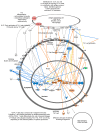Epigenetic Modifications of White Blood Cell DNA Caused by Transient Fetal Infection with Bovine Viral Diarrhea Virus
- PMID: 38793603
- PMCID: PMC11125956
- DOI: 10.3390/v16050721
Epigenetic Modifications of White Blood Cell DNA Caused by Transient Fetal Infection with Bovine Viral Diarrhea Virus
Abstract
Bovine viral diarrhea virus (BVDV) infections cause USD 1.5-2 billion in losses annually. Maternal BVDV after 150 days of gestation causes transient fetal infection (TI) in which the fetal immune response clears the virus. The impact of fetal TI BVDV infections on postnatal growth and white blood cell (WBC) methylome as an index of epigenetic modifications was examined by inoculating pregnant heifers with noncytopathic type 2 BVDV or media (sham-inoculated controls) on Day 175 of gestation to generate TI (n = 11) and control heifer calves (n = 12). Fetal infection in TI calves was confirmed by virus-neutralizing antibody titers at birth and control calves were seronegative. Both control and TI calves were negative for BVDV RNA in WBCs by RT-PCR. The mean weight of the TI calves was less than that of the controls (p < 0.05). DNA methyl seq analysis of WBC DNA demonstrated 2349 differentially methylated cytosines (p ≤ 0.05) including 1277 hypomethylated cytosines, 1072 hypermethylated cytosines, 84 differentially methylated regions based on CpGs in promoters, and 89 DMRs in islands of TI WBC DNA compared to controls. Fetal BVDV infection during late gestation resulted in epigenomic modifications predicted to affect fetal development and immune pathways, suggesting potential consequences for postnatal growth and health of TI cattle.
Keywords: bovine viral diarrhea virus; epigenetics; immune system; intrauterine growth restriction; pathway analysis; transient infection.
Conflict of interest statement
The authors declare no conflicts of interest.
Figures














Similar articles
-
Postnatal epigenetic differences in calves following transient fetal infection with bovine viral diarrhea virus.BMC Genomics. 2025 May 2;26(1):441. doi: 10.1186/s12864-025-11562-5. BMC Genomics. 2025. PMID: 40316897 Free PMC article.
-
Late gestation maternal infection with bovine viral diarrhea virus impacts offspring feedlot performance, digestion, blood parameters, and hot carcass weights.J Anim Sci. 2024 Jan 3;102:skae334. doi: 10.1093/jas/skae334. J Anim Sci. 2024. PMID: 39475068 Free PMC article.
-
Induction of interferon-gamma and downstream pathways during establishment of fetal persistent infection with bovine viral diarrhea virus.Virus Res. 2014 Apr;183:95-106. doi: 10.1016/j.virusres.2014.02.002. Epub 2014 Feb 12. Virus Res. 2014. PMID: 24530541
-
Maternal and fetal response to fetal persistent infection with bovine viral diarrhea virus.Am J Reprod Immunol. 2010 Oct;64(4):295-306. doi: 10.1111/j.1600-0897.2010.00904.x. Epub 2010 Jul 29. Am J Reprod Immunol. 2010. PMID: 20678166 Review.
-
[Bovine diarrhea virus: an update].Rev Argent Microbiol. 1997 Jan-Mar;29(1):47-61. Rev Argent Microbiol. 1997. PMID: 9229725 Review. Spanish.
Cited by
-
New Generation of Clinical Epigenetics Analysis and Diagnosis for Precision Medicine.Diagnostics (Basel). 2025 Jun 17;15(12):1539. doi: 10.3390/diagnostics15121539. Diagnostics (Basel). 2025. PMID: 40564859 Free PMC article. Review.
-
Genome-Wide Scans for Selection Signatures in Ningxia Angus Cattle Reveal Genetic Variants Associated with Economic and Adaptive Traits.Animals (Basel). 2024 Dec 30;15(1):58. doi: 10.3390/ani15010058. Animals (Basel). 2024. PMID: 39795001 Free PMC article.
-
Postnatal epigenetic differences in calves following transient fetal infection with bovine viral diarrhea virus.BMC Genomics. 2025 May 2;26(1):441. doi: 10.1186/s12864-025-11562-5. BMC Genomics. 2025. PMID: 40316897 Free PMC article.
References
MeSH terms
Substances
Grants and funding
LinkOut - more resources
Full Text Sources
Molecular Biology Databases

